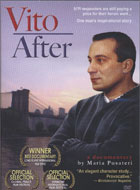
Vito After 2006
Distributed by DreamSlate Productions, 90 Meadowbrook Rd., Syosset, NY 11791; 516-729-7455
Produced by DreamSlate Productions
Directed by Maria Pusateri
DVD, color, 50 min.
Sr. High - Adult
Health Sciences, Environmental Health
Date Entered: 12/20/2007
Reviewed by Lori Widzinski, Health Sciences Library, University at Buffalo, State University of New YorkIf you think the tragedy and clean-up of 9/11 is over with, think again. It is a constant companion in the form of physical and emotional disorders for thousands of police, firefighters, and volunteers that helped immediately after the Twin Towers came down. This is the story of one NYPD detective, Vito Friscia, who helped with recovery and clean-up, and it further represents the stories of many others now suffering with a variety of physical and emotional symptoms.
Vito’s story is told by his sister-in-law, filmmaker Maria Pusateri. She deftly forms a moving portrait of Vito’s life post 9/11 through scenes with his family, his colleagues on the police force, the girls soccer team he coaches, and his visits to the doctor. Arriving on the scene as the second tower fell; Vito was covered by the initial smoke and debris cloud that blanketed the area. Later, all detectives were sent to the Staten Island landfill for recovery efforts, exposing them not only to the 9/11 debris, but the toxic elements of the landfill itself.
The film covers the period roughly from 2002 – 2005 as Vito uncovers the source of his chronic cough, stuffy nose and shortness of breath. Known as WTC cough, Vito has the same thing as many other rescuers who were involved in the cleanup efforts – chronic sinusitis (pansinus mucosal disease). His doctor shows Vito his cat scan, explaining the blocked and inflamed parts of his sinuses and the consequences of living with chronic sinusitis and the option of surgery. He also remarks on the number of other people exposed to 9/11 debris that have the same problem, which is puzzling physicians since this tissue is not responding as it usually does, by continually refreshing itself.
Pusateri captures the emotion of that horrible day as Vito describes what he saw and did at the scene to help. He details the incredibly long hours they put in at both the attack site and the landfill with constant exposure to all types of airborne substances. Vito explains working at the landfill and having to take off the white protective suits and masks to eat and drink right on-site, exposing the food to whatever chemicals were in the air. One expert in the film states that it will be 25 years before we know the true extent to the workers exposure. Years later as Vito and his police colleagues gather for a friendly dinner, they talk about the increasing number of their brethren who are sick or have died from various ailments linked to exposure to the smoke and ash. Their emotion, seemingly under the surface, can be clearly seen in their eyes.
The heroism and loyalty of those workers and volunteers who gave tirelessly of themselves after the attack on the towers continues as so many struggle with physical and emotional problems. Vito After is highly recommended for academic library collections in the health sciences, particularly environmental health, as well as collections devoted to the September 11th attack on the World Trade Center.